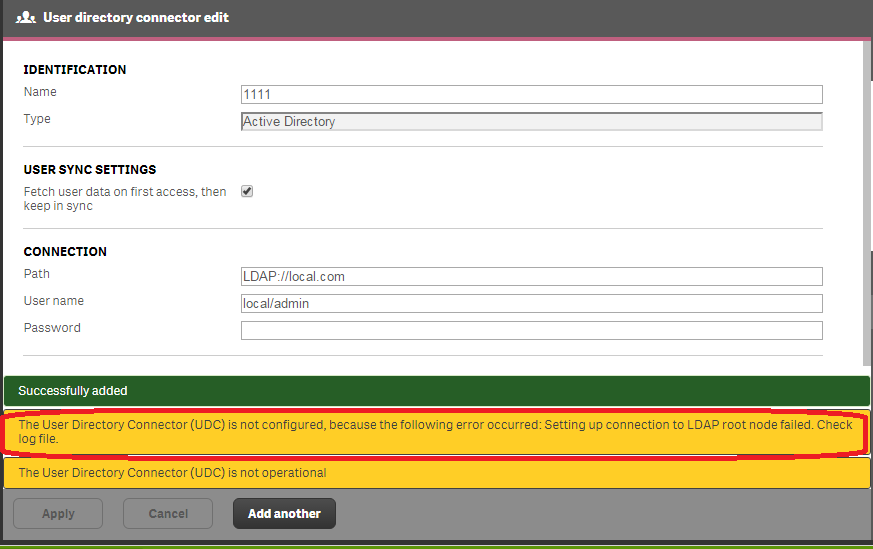Unlock a world of possibilities! Login now and discover the exclusive benefits awaiting you.
- Qlik Community
- :
- Forums
- :
- Analytics & AI
- :
- Products & Topics
- :
- Management & Governance
- :
- where I can find UDC log file?
- Subscribe to RSS Feed
- Mark Topic as New
- Mark Topic as Read
- Float this Topic for Current User
- Bookmark
- Subscribe
- Mute
- Printer Friendly Page
- Mark as New
- Bookmark
- Subscribe
- Mute
- Subscribe to RSS Feed
- Permalink
- Report Inappropriate Content
where I can find UDC log file?
Create a new connection to the user directory errors may occur are written to a log file. Where can I find this file?

Accepted Solutions
- Mark as New
- Bookmark
- Subscribe
- Mute
- Subscribe to RSS Feed
- Permalink
- Report Inappropriate Content
I clicked on the "?" icon in the User Directory Connectors page of QMC which takes you to the help site online. At the bottom of that page (User directory connectors) you can find the log location:
"The User Directory Connector (UDC) is not operational is displayed if the configuration of the connector properties does not enable communication with the user directory. Check the UserManagement_Repository log at this location: %ProgramData%\Qlik\Sense\Log\Repository."
- Mark as New
- Bookmark
- Subscribe
- Mute
- Subscribe to RSS Feed
- Permalink
- Report Inappropriate Content
I clicked on the "?" icon in the User Directory Connectors page of QMC which takes you to the help site online. At the bottom of that page (User directory connectors) you can find the log location:
"The User Directory Connector (UDC) is not operational is displayed if the configuration of the connector properties does not enable communication with the user directory. Check the UserManagement_Repository log at this location: %ProgramData%\Qlik\Sense\Log\Repository."
- Mark as New
- Bookmark
- Subscribe
- Mute
- Subscribe to RSS Feed
- Permalink
- Report Inappropriate Content
log file repeats the error message and does not contain any additional information.
my log file
| Sequence# | Message | Exception | StackTrace | ProxySessionId |
| 16 | Looking up RootDSE: LDAP://local.com/RootDSE | |||
| 17 | Fetching directoryentry LDAP://local.com/RootDSE failed: The server is not operational.↵↓ | |||
| 18 | Exception while initializing LDAP://local.com: Setting up connection to LDAP root node failed. Check log file. | |||
| 19 | Setup of ActiveDirectory UDC not successful: Setting up connection to LDAP root node failed. Check log file. | |||
| 20 | Setting up UDC of type Repository.UserDirectoryConnectors.LDAP.ActiveDirectory unsuccessful | Setting up connection to LDAP root node failed. Check log file. | ↵↓Server stack trace: ↵↓ at Repository.UserDirectoryConnectors.LDAP.LDAPRoot.FindEntry(String path, GenericLDAP ldap)↵↓ at Repository.UserDirectoryConnectors.LDAP.ActiveDirectory.FindRoot()↵↓ at Repository.UserDirectoryConnectors.LDAP.GenericLDAP.Setup(Logger logger)↵↓ at System.Runtime.Remoting.Messaging.StackBuilderSink._PrivateProcessMessage(IntPtr md, Object[] args, Object server, Object[]& outArgs)↵↓ at System.Runtime.Remoting.Messaging.StackBuilderSink.AsyncProcessMessage(IMessage msg, IMessageSink replySink)↵↓↵↓Exception rethrown at [0]: ↵↓ at System.Runtime.Remoting.Proxies.RealProxy.EndInvokeHelper(Message reqMsg, Boolean bProxyCase)↵↓ at System.Runtime.Remoting.Proxies.RemotingProxy.Invoke(Object NotUsed, MessageData& msgData)↵↓ at System.Func`1.EndInvoke(IAsyncResult result)↵↓ at Repository.Users.SafeUserDirectoryConnector.CallWithTimeout | |
- Mark as New
- Bookmark
- Subscribe
- Mute
- Subscribe to RSS Feed
- Permalink
- Report Inappropriate Content
So we find the log file but it is not helpful ![]() . I wonder what more detail the Qlik services could provide for a failed attempt like this?
. I wonder what more detail the Qlik services could provide for a failed attempt like this?
- Mark as New
- Bookmark
- Subscribe
- Mute
- Subscribe to RSS Feed
- Permalink
- Report Inappropriate Content
I do not fully understand the mechanism, but would like to see what that information such as "not the correct password" or "non-existent domain"
- Mark as New
- Bookmark
- Subscribe
- Mute
- Subscribe to RSS Feed
- Permalink
- Report Inappropriate Content
Hi Alex,
Did you get solution for your error message in log file???
Thank you